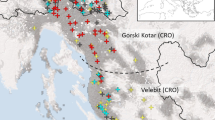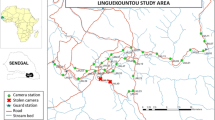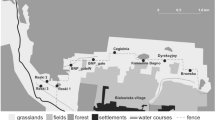Abstract
The use of non-invasive long-term monitoring data to estimate home ranges of the critically endangered Iberian lynx has been evaluated. This programme began in 2002 and consisting of both annual latrine and camera-trap surveys, with the aims of detecting and individually identifying the maximum number of individuals and delineating female home range boundaries. Radio-tracking data were used to evaluate the accuracy of home range estimates constructed with camera-trapping data. There was little overlap of camera-trapping home ranges (7.0% ± 1.47), which suggests the existence of real territories consistent with the land tenure system expected for the species. Camera trapping home range estimates were half the size of radio-tracking data (54.1% ± 6.0 of overlapping). When comparing core areas, only the radio-tracking data did not yield improved results (36.7 ± 5.4 of overlapping). Estimation of territories, which escaped detection each year, ranged from 0.0% to 5.7%. The results produced by camera-trapping data in this non-intrusive monitoring programme could be considered precise, and are therefore well suited to provide the knowledge required for appropriate conservation of this endangered species.



Similar content being viewed by others
References
Cabrera A (1914) Fauna Ibérica. Mamíferos. Museo Nacional de Ciencias Naturales, Madrid
Cole C (1949) The measurements of interspecific association. Ecology 30:411–424
Carbone C, Christie CSK, Coulson T, Franklin N, Ginsberg JR, Griffiths M, Holden J, Kawanishi L, Kinnaird M, Laidlaw R, Lynam A, Macdonald DW, Martyr D, Mcdougal C, Nath L, O'brien T, Seidensticker J, Smith DJL, Sunquist M, Wan TR, Shahruddin WN (2001) The use of photographic rates to estimate of tigers and other cryptic mammals. Anim Conservat 4:75–79
Davinson A, Birks JDS, Brookes RC, Braithwaite TC, Messenger JE (2002) On the origin of faeces: morphological versus molecular methods for surveying rare carnivores from their scats. J Zool 257:141–143
Ferreras P, Beltrán JF, Aldama J, Delibes M (1997) Spatial organization and land tenure system in the endangered Iberian lynx (Lynx pardinus Temminck, 1824). J Zool (Lond) 243:163–189
Garrote G, Perez de Ayala R, Pereira P, Robles F, Guzmán N, García FJ, Iglesias MC, Hervás J, Fajardo I, Simón M, Barroso JL (2010) Estimation of the Iberian lynx (Lynx pardinus) population in the Doñana area, SW Spain, using capture-recapture analysis of camera-trapping data. Eur J Wild Res 57:355–362. doi:DOI10.1007/s10344-010-0440-7
Gil JM, Molino F, Valenzuela G (1997) Efecto de la litología y de las repoblaciones forestales sobre la distribución y la abundancia del Lince Ibérico (Lynx pardina) en la Sierra de Andújar. Aegypius 14:21–28
Gil-Sánchez JM, Simón MA, Cadenas R, Bueno J, Moral M, Rodríguez-Siles J (2011) Current status of the Iberian lynx (Lynx pardinus) in eastern Sierra Morena, southern Spain. Wildl Biol Pract (in press)
Ghoddousi A, Hamidi AHK, Ghadirian T, Ashayeri TD, Moshiri H, Khorozyan I (2008) The status of the Persian leopard in Bamu National Park, Iran. Cat News 49:10–13
Guil F, Agudín S, El-Khadir N, Fernandez-Olalla M, Figueredo J, Domínguez FG, Garzon P, Gonzalez G, Muñoz-Igualada J, Oria J (2010) Factors conditioning the camera-trapping efficiency for the Iberian lynx (Lynx pardinus). Eur J Wildl Res 56:633–640
Guzmán JN, García FJ, Garrote G, Perez R, Iglesias C (2004) El lince ibérico (Lynx pardinus) en España y Portugal. Censo – diagnóstico de sus poblaciones. Dirección General para la Biodiversidad, Madrid
Jackson RM, Rhoe SD, Wangchuk R, Hunter DD (2005) Surveying snow leopard populations with emphasis on camera trapping. A handbook. The snow leopard conservancy. Sonoma, California
IUCN (2007) IUCN Red List of Threatened Species. http://www.iucnredlist.org. Accessed 01 Sep 2008
Junta de Andalucía (2009) Conservación y reintroducción del lince ibérico en Andalucía, acción D.1.2. Resultados del programa de seguimiento de las poblaciones de lince ibérico y conejo en las áreas de distribución actual de la especie. Evaluación de las actuaciones de conservación: alimentación suplementaria y mejora del conejo. Memoria de resultados en Sierra Morena, 3ª anualidad: Agosto 2008–Julio 2009. Sevilla (unpublished report)
Karanth KU, Nichols JD (1998) Estimation of tiger densities in India using photographic captures and recaptures. Ecology 79:2852–2862
Karanth KU, Nichols JD (2010) No-invasive survey methods for assessing tiger populations. In: Tilson R, Nyhus PJ (eds) Tigers of the world. The science, politics and conservation of Panthera tigris. Academic, London, pp 241–292
MacKenzie DI, Nichols JD, Royle JA, Pollock KH, Bailey LL, Hines JE (2006) Occupancy estimation and modelling: inferring patterns and dynamics of species occurrence. Academic, New York, USA
Maffei L, Cuéllar E, Noss A (2004) One thousand jaguars (Panthera onca) in Bolivia's Chaco? Camera trapping in the Kaa-Iya National Park. J Zool (Lond) 262:295–304
Marino J, Lucherini M, Villalba ML, Bennett M, Cossíos D, Iriarte A, Perovic PG, Sillero-Zubiri C (2010) Highland cats: ecology and conservation of the rare and elusive Andean cat. In: Macdonald DW, Loveridge AJ (eds) Biology and conservation of the wild felids. Oxford University Press, Oxford and New York, pp 581–598
Marker LL, Fabiano E, Nghikembua M (2008) The use of remote camera traps to estimate density of freeranging cheetahs in North-Central Namibia. Cat News 49:22–24
McCain EB, Childs JC (2008) Evidence of resident jaguars (Panthera onca) in the southwestern United States and the implications for conservation. J Mammal 89:1–10
McCarthy TM, Fuller TK, Munhtosog B (2005) Movements and activities of snow leopards in Southwestern Mongolia. Biol Conservat 124:527–537
Millspaugh JJ, Marzluff JM (2001) Radio tracking and animal populations. Academic, San Diego
Nowel K, Jackson P (1996) Wild cats. Status survey and conservation action plan. IUCN, Gland
O'Connell AF, Nichols JD, Karanth KU (2011) Camera traps in animal ecology. Methods and analyses. Springer, Tokyo
Palomares F, Delibes M, Revilla E, Calzada J, Frediani JM (2001) Spatial ecology of Iberian lynx and abundance of European rabbits in southwestern Spain. Wildl Monogr 148:1–3
Palomares F, Godoy JA, Piriz A, O'Brien SJ, Johnson WE (2002) Faecal genetic analysis to determine the presence and distribution of elusive carnivores: design and feasibility for the Iberian lynx. Mol Ecol 11:2171–2182
Rodríguez A, Delibes M (2004) Patterns and causes of non-natural mortality in the Iberian lynx during a 40 year period of range contraction. Biol Conserv 118:151–161
Silver SC, Ostro LET, Marsh LK, Maffei L, Noss AJ, Kelly MJ, Wallace RB, Gomez H, Ayala G (2004) The use of camera traps for estimating jaguar Panthera onca abundance and density using capture/recapture analysis. Oryx 38:1–7
Simón MA (2008) Current status of Iberian lynx in Andalucía. In: de Andalucía J (ed) Proceedings of the III Iberian lynx conservation seminar. Huelva, Spain, pp 75–84
Soisalo MK, Cavalcanti SMC (2006) Estimating the density of a jaguar population in the Brazilian Pantanal using camera-traps and capture-recapture sampling in combination with GPS radio-telemetry. Biol Conservat 129:487–496
Sunquist M, Sunquist F (2002) Wild cats of the world. The University of Chicago Press, Chicago
Trolle M, Kery M (2003) Estimation of ocelot density in the Pantanal using capture-recapture analysis of camera-trapping data. J Mammal 84:607–614
Wallace RB, Gomez H, Ayala G, Espinoza F (2003) Camera trapping of jaguar (Panthera onca) in the Tuichi Valley, Bolivia. Mastozool Neotrop 10:133–139
Valverde JA (1963) Información sobre el lince español. Servicio Nacional de Pesca Fluvial y Caza, Madrid
Werdelin L (1981) The evolution of lynxes. Ann Zool Fenn 18:37–71
Wilson DE, Mittermeier RA (2009) Handbook of the mammals of the world. vol. 1. Carnivores. Lynx Editions, Barcelona
Acknowledgements
The study was supported by the projects LIFE NAT//E//8609 “Recuperación del Lince Ibérico en Andalucía”, and LIFE 02 NAT/E/209 “Conservación y Reintroducción del Lince Ibérico en Andalucía”. We are especially grateful to people who assisted with camera-trapping surveys: Gerardo Valenzuela, Maribel García, Miguel A. Díaz, Rafael Arenas, Antonio Leiva and Fernando Almagro (EGMASA-CMA Junta de Andalucía), Gregorio Fernández, Fernando Silvestre, Juan Figueredo and Sandra Agudí (CBD-Hábitat Fundation), Ramón Pérez, Concepción Iglesias and Nicolás Guzman (TRAGSA-MIMAM), Alfonso Moreno and Jesús Cobo (Adena-WWF), Aquilino Duque (CMA Junta de Andalucía). Rafael Cadenas, Roberto García, Jorge Alcaina, Rafael Solano, Ana Pello, Magdalena Vara and Inmaculada Tenorio (EGMASA-CMA Junta de Andalucía) provided logistic support. We also wish to express our gratitude to the directors of the natural parks of Sierra de Andújar and Sierras de Cardeña y Montoro, Ascensión García, Jose M. Quero and Jose M. Molina. Emil McCain (Iberus Medio Ambiente S.L.) revised and improved the use of the English language. We thank three anonymous reviewers for their comments.
Author information
Authors and Affiliations
Corresponding author
Additional information
Communicated by C. Gortázar
Rights and permissions
About this article
Cite this article
Gil-Sánchez, J.M., Moral, M., Bueno, J. et al. The use of camera trapping for estimating Iberian lynx (Lynx pardinus) home ranges. Eur J Wildl Res 57, 1203–1211 (2011). https://doi.org/10.1007/s10344-011-0533-y
Received:
Revised:
Accepted:
Published:
Issue Date:
DOI: https://doi.org/10.1007/s10344-011-0533-y




